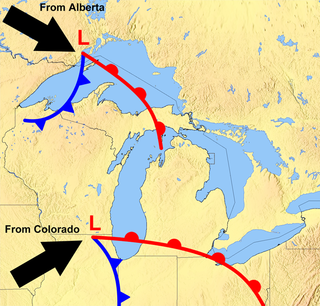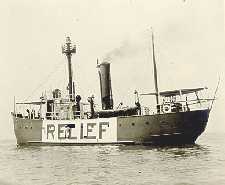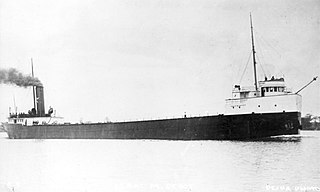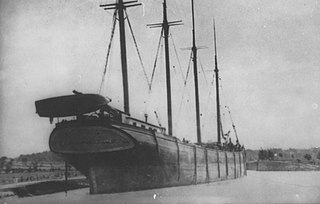
The Great Lakes Storm of 1913 was a blizzard with hurricane-force winds that devastated the Great Lakes Basin in the Midwestern United States and Southwestern Ontario, Canada, from November 7 to 10, 1913. The storm was most powerful on November 9, battering and overturning ships on four of the five Great Lakes, particularly Lake Huron.

Lake freighters, or lakers, are bulk carrier vessels that operate on the Great Lakes of North America. These vessels are traditionally called boats, although classified as ships.

The United States lightship Huron (LV-103) is a lightvessel that was launched in 1920. She is now a museum ship moored in Pine Grove Park, Port Huron, St. Clair County, Michigan.

SS Daniel J. Morrell was a 603-foot (184 m) Great Lakes freighter that broke up in a strong storm on Lake Huron on 29 November 1966, taking with her 28 of her 29 crewmen. The freighter was used to carry bulk cargoes such as iron ore but was running with only ballast when the 60-year-old ship sank. When built in 1906, she was the "Queen of the Lakes", being the longest ship then in service on the Great Lakes.

The SS James Carruthers was a Canadian Great Lakes freighter built in 1913. The ship was owned by the St. Lawrence & Chicago Steam and Navigation Company of Toronto, Ontario, with the official registry number 131090.

SS Wexford was a steel-hulled, propeller-driven, cargo ship built by William Doxford & Sons. at Sunderland, Great Britain in 1883. The official number for Wexford was 87342 with the hull number 00145. The ship was lost on Lake Huron with all hands on 9 November 1913 during the Great Lakes storm of 1913. Sources cite conflicting numbers for crew lost with 17 to 24 crew being listed. Her cargo at the time of loss was 96,000 bushels of wheat. The wreck was discovered 25 August 2000 sitting intact and upright in 75 feet (23 m) of water on the lake bottom. A copper wreath was placed on the wreck to honor the crew of the 100th Anniversary of The Great Storm of 1913.

The SS Regina was a cargo ship built for the Merchant Mutual Line and home ported in Montreal, Quebec. Named after Regina, Saskatchewan, Regina had a tonnage of 1,956 gross register tons (GRT) and a crew of 32.

The SS Hydrus was an American steel-hulled Great Lakes bulk freighter, constructed in 1903 and launched as the R.E. Schuck. She was following the SS James Carruthers heading south on Lake Huron while carrying a load of iron ore when she and the Carruthers were caught in the Great Lakes Storm of 1913.

The J. B. Ford was a steamship bulk freighter that saw service for 112 years on the Great Lakes of the United States and Canada.

The following events occurred in November 1913:

SS Isaac M. Scott was an American Great Lakes freighter that sank during the Great Lakes Storm of 1913 in Lake Huron, 6 to 7 miles northeast of Thunder Bay Island, while she was traveling from Cleveland, Ohio, United States to Milwaukee, Wisconsin, United States with a cargo of coal.

The SS Pewabic was a package freighter that served ports on the Upper Great Lakes. She was launched in October 1863, fitted out in the spring of 1864, and was in active service until she sank off Thunder Bay Island in Lake Huron on August 9, 1865, due to collision with her sister vessel. There was significant loss of life, with a number variously estimated at 100 or 125 passengers and crew of the stricken vessel going down with the ship. If the higher number is accepted, the loss of life made this disaster, in terms of loss of life from the sinking of a single vessel, the seventh-worst tragedy in the history of the Great Lakes, and the worst ever on Lake Huron. The sunken hull of the package freighter is a feature of the present-day Thunder Bay National Marine Sanctuary.

SS Clifton, originally Samuel Mather, was a whaleback lake freighter built in 1892 for service on the Great Lakes. She was 308 foot (94 m) long, 30 foot (9.1 m) beam, and 24 foot (7.3 m) depth, and had a 3,500 ton capacity. The self-propelled barge was built by the American Steel Barge Company in West Superior, Wisconsin. Her builders used a design well-suited to carry iron ore, her intended trade. The new vessel was christened Samuel Mather, after a cofounder of Pickands Mather and Company, which at the time was the second largest fleet on the Great Lakes.

Minnedosa was a four-masted wooden Great Lakes schooner launched in 1890. This was late in the era of sailing ships and it spent its career as a schooner barge, towed by a steam tug. It was lost with its nine crew and passengers and a heavy load of grain in a storm October 20, 1905 on Lake Huron.

SS Ira H. Owen was a steel-hulled American lake freighter in service between 1887 and 1905. One of the first steel lake freighters, she was built in 1887 in Cleveland, Ohio, by the Globe Iron Works Company, and was built for the Owen Line of Chicago, Illinois. Early in her career, Ira H. Owen carried iron ore from Escanaba, Michigan. In April 1898, Ira H. Owen was chartered by the Baltimore & Ohio Railroad. She was sold to the National Steamship Company of Chicago, on December 30, 1899, for whom she frequently carried coal and grain. Throughout her career, Ira H. Owen was involved in multiple accidents and incidents.

Howard M. Hanna Jr. was a 500 ft (150 m) Great Lakes freighter that had a lengthy, 75-year career on the Great Lakes of Canada and America. Hanna was a product of the Cleveland Shipbuilding Company of Cleveland, Ohio. The ship was commissioned by the Richardson Transportation Company to haul iron ore, coal and grain. She had a cargo capacity of 9,200 tons of bulk cargo, or 323,000 bushels of grain.

The Henry Phipps was a 601-foot-long (183 m) American Great Lakes freighter that served on the Great Lakes of North America from her launching in 1907 to her scrapping in 1976 by Hyman Michaels Company of Duluth, Minnesota. The Phipps was used to haul bulk cargoes such as iron ore, coal, grain and occasionally limestone.

SS Choctaw was a steel-hulled American freighter in service between 1892 and 1915, on the Great Lakes of North America. She was a so-called monitor vessel, containing elements of traditional lake freighters and the whaleback ships designed by Alexander McDougall. Choctaw was built in 1892 by the Cleveland Shipbuilding Company in Cleveland, Ohio, and was originally owned by the Lake Superior Iron Company. She was sold to the Cleveland-Cliffs Iron Company in 1894 and spent the rest of her working life with it. On her regular route between Detroit, Escanaba, Marquette, and Cleveland, she carried iron ore downbound, and coal upbound.


















